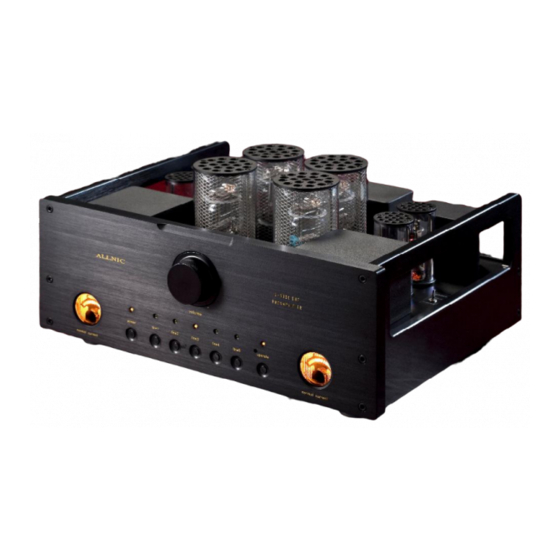ALLNIC AUDIO L-5000 DHT Panduan Pemilik - Halaman 5
Jelajahi secara online atau unduh pdf Panduan Pemilik untuk Penguat ALLNIC AUDIO L-5000 DHT. ALLNIC AUDIO L-5000 DHT 14 halaman. Line stage preamplifier

retained for replacements, should that ever become
necessary, something that is unlikely for a very, very long
time – unless one drops the tube! This is because the
qualities of the valves combined with the circuit in which
they function will extend their life to the utmost limits,
very, very much beyond 10,000 hours.
The L-5000 DHT is Allnic Audio's best line stage
preamplifier. Like all Allnic Audio products, it uses
Permalloy (Iron and nickel alloy) for its transformer
cores. Allnic is grateful to Mr. G.W. Elmen of Western
Electric for inventing Permalloy for transformer core use,
and in so doing, providing an enormous service to
recorded music listeners everywhere.
The L-5000 DHT has the following features:
Line output transformer coupling – The L-5000 DHT is
"transformer coupled". In tube amp circuitry, there are
two coupling methods; one is capacitor coupling and
the other is transformer coupling. Capacitor coupling is
the traditional, low cost method. It is somewhat stable
but transfers only voltage, not wattage (i.e., not real
energy). With transformer coupling, about 90% of real
wattage is transferred (there is still a transformer loss
of about10% of wattage – voltage is not affected).
Transformer coupling is superior to capacitor coupling.
However, all the advantages of transformer coupling
depend on the quality of the transformer and on the
choice of tubes. Allnic Audio manufactures its own
transformers and uses what it views to be the best core
material, Permalloy. Allnic Audio's unprecedented,
wide (16Hz ~ 75kHz, -3db), low distortional, and ultra-
ultra-flexible (up to 50kHz square wave response)
output transformer helps Allnic Audio to realize the
ideal transformer coupled preamplifier. Of course, gain
tubes are also carefully selected for three critical
factors for function with the Permalloy output
transformers: high gm, low internal resistance and high
mu.
Constant and low output impedance – One of the
benefits of transformer coupling is that it facilitates
constant low output impedance. Low output
impedance is critical to the design of a good
preamplifier. The L-5000 DHT has a 120 ohm (120Ω)
constant output impedance at all frequencies. In
capacitor coupling (C-R coupling), a "cathode follower
circuit" is usually used to lower output impedance.
Unfortunately, this method of lowering output
impedance is accompanied by high distortion and has
an "L" shaped output impedance curve. Please
compare the two graphs below, especially for low
frequency response.
No negative feedback design
Advanced tube technology voltage regulation - For
quieter and more dynamic operation, the L-5000 DHT
has an ultra high speed automatic voltage regulation
circuit, utilizing vacuum tubes. This also protects the
amplifying tubes from change in the AC line supply
and copes with any abrupt, internal current demand.
New vacuum tube damping technology – Allnic
Audio's patented "Absorb GEL tube damper"
technology prevents harmful vibrations from
reaching the signal / gain tubes and, therefore,
prevents microphonic noise propagation in the tubes.
The Allnic Audio Absorb Gel damper technology
effectively solves a problem that plagues most tube,
and especially DHT, amplification systems. Provided
other tube components do not introduce
microphonic noise into your system, with the Absorb
Gel damping system, you will enjoy a degree of
transparent sound that will surprise and please you.
Precision attenuator volume control – The L-5000
DHT does not employ a digital IC volume control or a
low-cost carbon film volume control with a motor.
Allnic Audio has developed a precision oil clutched
motorized attenuator; the L-5000 DHT has no (± 0db)
channel unbalance at any volume level.
Pure Class A operation
Pure balanced output stage
As are all Allnic Audio products, the L-5000 is fully
RoHS (EU Reduction of Hazardous Substances
regulation) compliant in construction and materials
5
